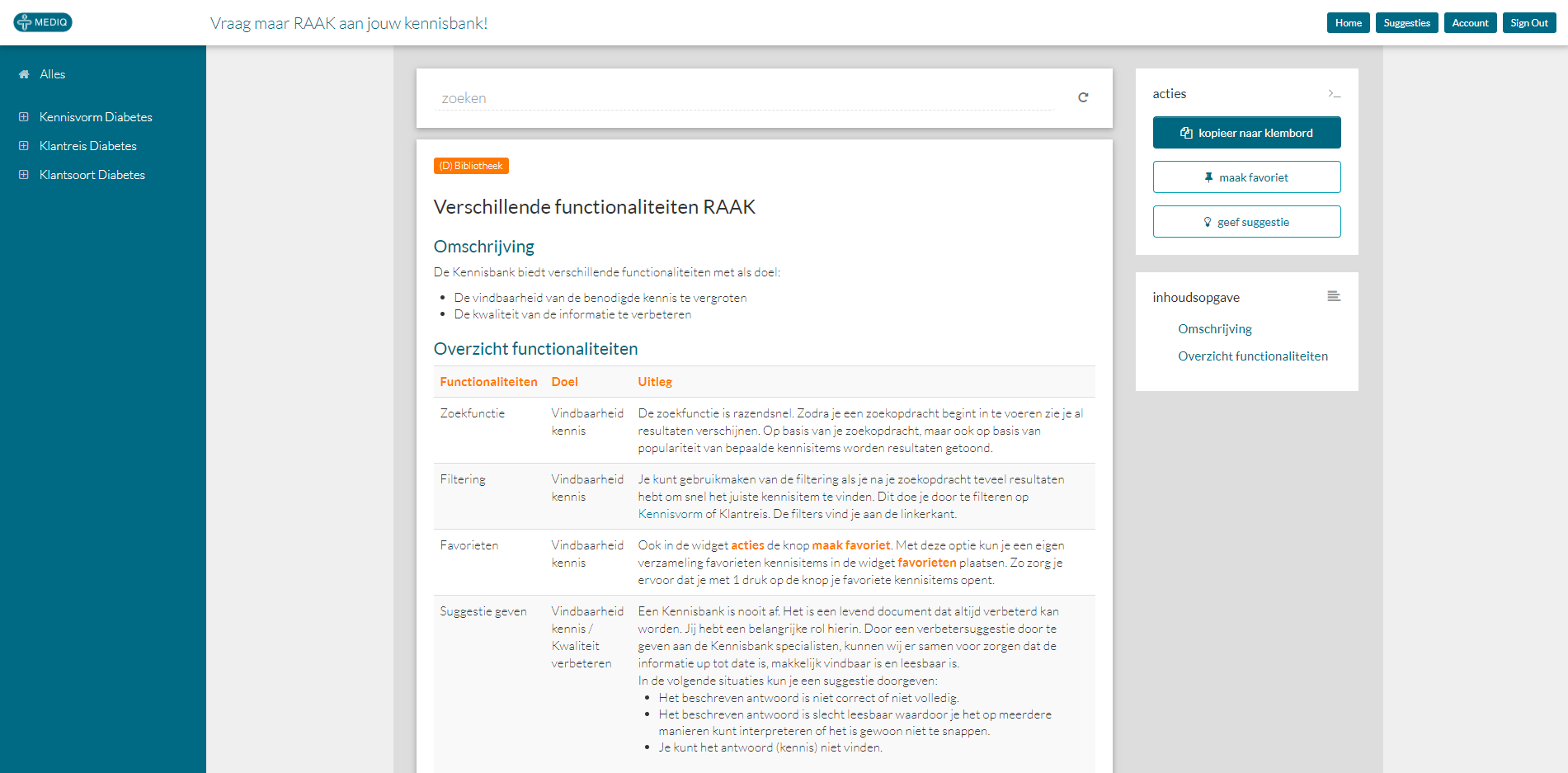Why organisations must do ‘’something’’ with knowledge management
The term knowledge management is most likely one that you come across frequently within organisations. You know you have to do something with it. But what? And what is the reality in many businesses?
Knowledge is often scattered throughout the organisation. Why? Because it is stored in the minds of employees. Then, when a question from a customer or employee needs to be answered, various colleagues need to be consulted. An unnecessarily long search for information is conducted, and occasionally it turns out that there is no one who knows the answer. Sometimes, searches also have to be conducted in one of the organisation's systems.
What happens if a knowledgeable employee leaves the organisation without transferring their knowledge to others? That would be a missed opportunity. We asked customer contact consultant and knowledge manager Ger Koedam why organisations should do "something" with knowledge management.
What is knowledge management?
‘’Well-organised knowledge management enables an organisation to answer customer and employee questions properly and in a validated manner at the outset.’’
Maar wat is ‘kennismanagement’ eigenlijk? “Praktisch gezien is het een proces waarmee je kennis in een organisatie borgt en vervolgens slim distribueert, zodat iedereen op het juiste moment en tijdstip over relevante kennis kan beschikken”, vertelt Koedam.
“Vergelijk het met een bibliotheek. Als je die binnenwandelt, dan weet je dat er veel informatie is te vinden. Maar wat je ziet, zijn boeken. Nog geen direct toepasbare kennis. Als je dat wilt vinden, dan zal je eerst op zoek moeten gaan naar dat ene boek waarin het antwoord op jouw vraag staat. En je moet niet alleen op zoek naar dat boek; je moet in de inhoudsopgave kijken, je moet bladeren naar de juiste pagina en dan al lezend op zoek naar het antwoord.
Kortom, een lang proces met een flink aantal stappen waar je veel tijd aan kwijt bent. Richt je kennismanagement op een goede manier in, dan ben je in staat om met een paar simpele muisklikken in één keer toepasbare kennis te vinden en te gebruiken.’’
But what exactly is 'knowledge management'? "In practical terms, it is a process by which you store knowledge in an organisation and then distribute it smartly so that relevant knowledge is available to everyone at the right time and place," Koedam explains.
"You can compare it to a library. When you walk into a library, you know that you can find plenty of information there. But what you see is books. At first glance, there is no directly applicable knowledge. If you want to find that knowledge, you will first have to look for a particular book that contains the answer to your question. And it's not only the book you have to look for. Once you have found the book, you have to check the table of contents, you have to flip to the right page, and then you have to read through the content to find the answer you're looking for.
In short, it is a long process with many time-consuming steps. If you set up knowledge management properly, you will be able to find and use relevant knowledge in one go with a few simple clicks.''

Why knowledge management?
Knowledge management prevents knowledge from disappearing from an organisation, or prevents you from constantly having to reinvent the wheel, as in the library example. It helps employees to find answers quickly to important questions from customers or colleagues.
However, there are multiple reasons why organisations should implement knowledge management. Below, we discuss four of these.
Answering customer questions efficiently
Customers ask questions. And this is great, because it shows that they are interested in your organisation. However, your customers also expect to receive the right answers the first time. If they are asking standard questions, you can usually respond quickly and with a default answer. However, this becomes more challenging when customers pose more complex questions. You still need to provide an answer, and what you, as a customer service employee, would rather not say in that scenario is: "Good question, I'm going to find out for you. I'll get back to you as soon as possible". Because if "as soon as possible" is not fast enough, the customer will reach out again via phone, email, or other customer contact channels.
''If you implement knowledge management properly using the right software, such as a knowledge base, you make it possible to answer even more difficult customer questions correctly in one go, without having to conduct an extensive search throughout the company. And you also do not have to repeat this process when the same question is asked again three weeks later'', Koedam explains.
Uniform answers via every channel
''And how great would it be if that same customer did not have to contact a customer service representative, but could find the answer easily on the organisation's website? Surely that is much better than sending an email and waiting three days for an answer, or waiting in a phone queue for a long time only to be told once you get through to someone that you will be called back?"
Koedam indicates that you can achieve this with a knowledge management system, in which you store all knowledge centrally and make it accessible to anyone who needs it. Why centrally? Some organisations still maintain separate databases for each customer contact channel. Not only does this require a lot of work, but it is also prone to errors.
If you make use of one central source, you can be sure that the answers provided via different channels are always the same. Connecting all the different systems is nowhere near as difficult and costly as it used to be. And knowledge can be made available at different levels. For example, a single article can contain information of which 80% can be found publicly on a website, while the remaining 20% is only available to the customer service team.
For organisations that want to go one step further, there is an additional option of a software robot. This robot can assess incoming email, check whether there is an appropriate response in the knowledge management system, and then automatically send a reply.
''This way, you not only ensure that processes are more efficient, but also that you provide uniform answers via all customer contact channels. For both the customer and the employee, processes become clearer and more efficient. And you build a consistent brand experience.''
You might also be interested in the following article: create a uniform and consistent brand experience with the perfect omnichannel strategy.
Creating more efficient business processes
Using a knowledge management system comes with an additional benefit. "It is obviously good that answers to questions can be found quickly, but if the same question is asked 10 times a day, it also says something. You might need to adjust an organisational process, for example by changing text or providing more information. Thus, knowledge management also provides insight," says Koedam.
Faster onboarding of new employees
Organisations cannot avoid onboarding new staff. In this process, too, a knowledge management system can provide important support. This is especially true if employee turnover is high. A well-designed system allows for quicker onboarding, as content from the knowledge management system could also be used in e-learning or in a handbook.
In an average customer service department, the onboarding process can take two to six months, and only after this period can an employee start working independently. New employees tend to have many questions. And these questions are usually answered by colleagues who have been around a bit longer. Therefore, two people are needed for knowledge sharing. If you replace part of this process with a knowledge management system, then the new employee will have their own source of information. And the colleague who would have had to assist them can get on with their own work.
‘’Knowledge in the right place ensures unambiguous answers’’ – Mediq
A great example of successfully implemented knowledge management is Mediq. In this organisation, validated information may sometimes literally be a matter of life and death. Mediq used knowledge management to set up their processes in such a way that all employees now always know what is going on in the organisation and can quickly access the right information - in several physically separate locations, where information was scattered among different departments. Mediq uses knowledge management for five key areas:
- Onboarding new employees
- Knowledge sharing within the organisation
- Validated responses across all channels and from all countries
- Correct execution of specific medical instructions
- Self-service via the website
Read more about the client case Mediq.
Businesses' biggest pitfalls in knowledge management
Given the above, is knowledge management always easy to implement? Koedam's response is clear: "no".
''People sometimes don't give much thought to what is involved when you start implementing knowledge management. It often starts with awareness within the organisation, generating support, and designing your business processes in such a way that your organisation can grow as a result.''
Lack of support
The most important thing within an organisation is that everyone realises that knowledge management is necessary. Because if this is not the case, then knowledge management is a great concept, but no one is going to do anything with it.
No knowledge team
Besides generating support, it is important to put together a team to work on the knowledge management system. This can include existing employees who are given additional tasks, as well as new employees. If you don't have a dedicated team working on it, the knowledge base will quickly become outdated and new content will not be added. Before you know it, you are then back to square one and everyone will proverbially go back to the library.
Copying and pasting existing content into the new system
"We already have a sort of knowledge base, in the form of SharePoint or a Wiki page. Surely we can simply put this content into the new system?" Technically it is possible, but the question is whether it is smart to do so. 'Garbage in, garbage out' might be the case here. In the beginning, it saves you time, but in the long run you might need to invest that time in answering people's questions, because they still can't find the answer they're looking for. Because they couldn't find it in the old system either. And why would they be able to find it in the new knowledge base if this contains the same outdated content?

Waarom bedrijven niet zonder kunnen
''Kennismanagement helpt organisaties om iedere keer een beetje beter te worden. Het geeft inzicht in klantvragen en bedrijfsprocessen en zorgt voor een efficiënte afhandeling ervan. Ook zorgt het voor uniforme antwoorden via elk klantcontactkanaal en worden medewerkers sneller ingewerkt. Mits kennismanagement natuurlijk goed is ingericht met een kennismanagementsysteem dat daarbij past.
Misschien kan ik je hiermee op weg helpen. Neem vrijblijvend contact met me op voor een gesprek.''

Why businesses can't go without
''Knowledge management helps organisations become a little better all the time. It provides insight into customer queries and business processes and ensures efficiency. It also ensures uniform answers via every customer contact channel and enables quicker employee onboarding. The prerequisite here is, of course, that knowledge management is set up properly with a knowledge management system to match.
I may be able to help you get started with this. Contact me for a no-obligation consultation.''

Meer weten over kennismanagement binnen jouw organisatie?
Download dan hier jouw gratis whitepaper. In dit whitepaper vertellen wij jou hoe kennismanagement een aanvullende toepassing kan zijn binnen jouw organisatie en geven we jouw 5 tips voor het volledig en juist invullen van een kennisbank.
Want to know more about knowledge management within your organisation?
Download your free white paper here. In this white paper, we will discuss how knowledge management can complement your existing organisational processes and give you 5 tips for populating a knowledge base completely and correctly.

